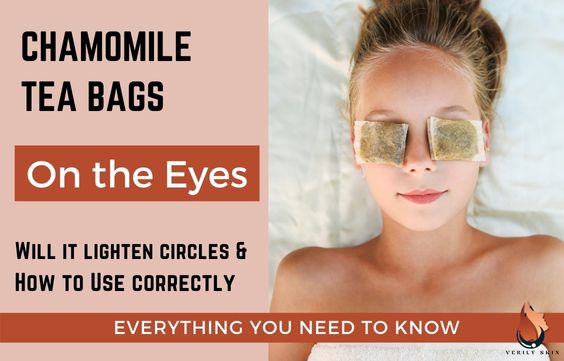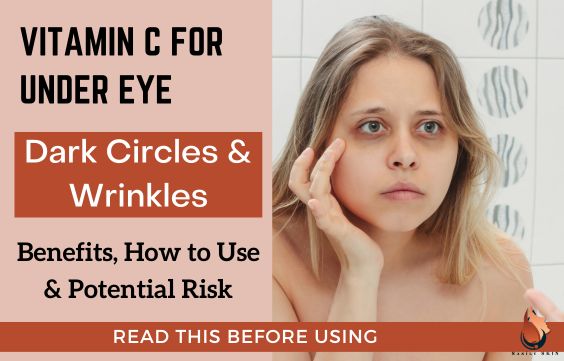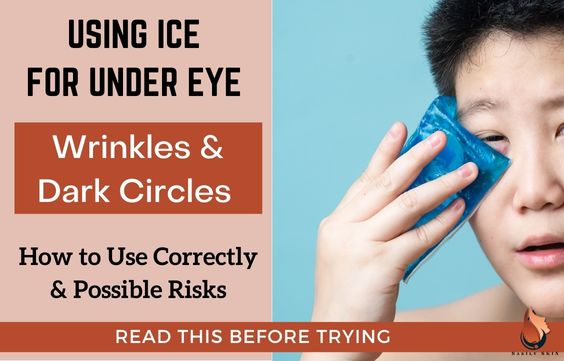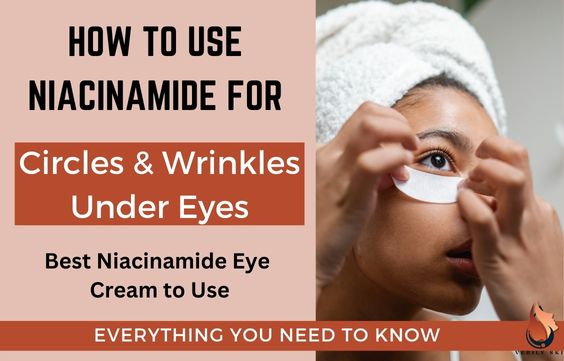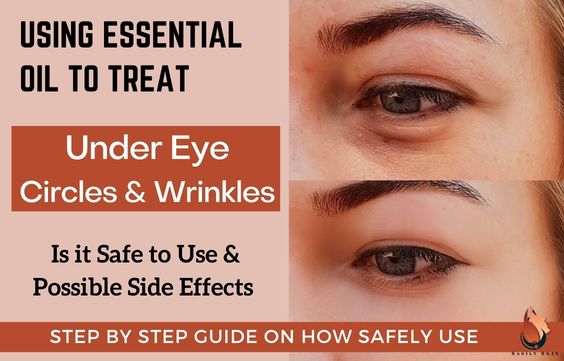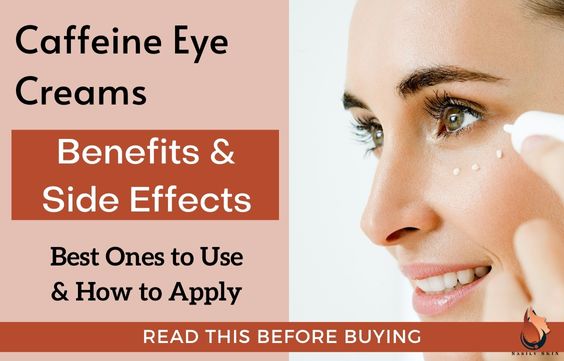10 Medical & Home Remedies For Under Eye Dark Circles
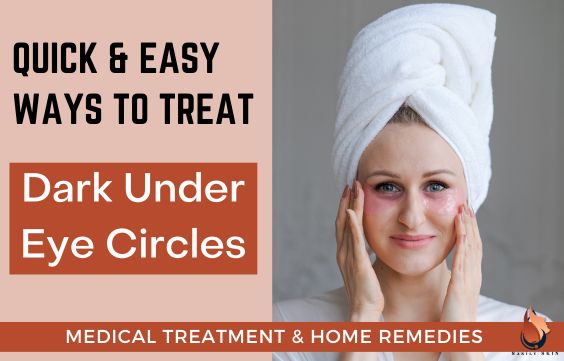
There are so many medical & home remedies for under eye dark circles. I could not pass up the chance to share the best of them with you in one place.
My team and I went on a quest to try different remedies to see how they would work. This article contains the most effective remedies that we have tried over the last year.
DIY Home Remedies For Under Eye Dark Circles
1- Turmeric
Tumeric is a tried and true ingredient in DIY and traditional skincare. It has been used for ages for healthy, glowing skin and is all-natural!
It can be safely used under the eyes as a paste or mixed into eye creams, scrubs, under-eye masks, etc.
The antioxidant and anti-inflammatory effects of turmeric are well-recognized for reducing puffiness and inflammation beneath the eyes.
Turmeric’s curcumin component also helps lighten the skin around the eyes by inhibiting melanin synthesis in the skin itself. I am Indian and I grew up with turmeric being a regular in my skin routine. And I have seen it work wonders on my skin and other family members who have tried it.
Read this article: How to Use Turmeric for Under Eye Dark Circles & Wrinkles to see the best DIY recipes for turmeric under-eye treatments.
2- Lemon
Once used correctly and cautiously, lemon juice can lighten up dark circles.
Keep in mind that lemon juice is acidic. It can irritate the thin, sensitive skin under your eyes. However, I recommend using lemon juice with other soothing and hydrating ingredients. These will also nourish the area and prevent irritation.
When we tried it we ensured we used a little at the beginning to see how it would affect our under eye skin.
Lemon juice is rich in Ascorbic acid (Vitamin C), Citric Acid, and trace amounts of Malic Acid. Vitamin C affects melanin production in the skin and together with the other acids, it exfoliates the skin as well. This combination of actions gradually lightens the skin.
Read this article: Lemon for Under-Eye Circles & Wrinkles – Benefits & Risks to learn all about using lemon for your under eyes. This includes the benefits, side effects and some great DIY recipes!
3- Honey
Honey is another natural ingredient that has been used for ages in skincare and traditional medicine. It can be safely applied under your eyes with great results.
It has wonderful anti-inflammatory and therapeutic effects that aid in skin healing and moisturization. The under-eye skin is safe since it is perfect for fragile skin. Additionally, it contains some naturally occurring bleaching qualities. These aid in lowering the melanin content of the skin around the eyes.
Honey is so versatile. It can be mixed with a wide range of other ingredients in DIY recipes or even commercial products. So, it either be applied directly on the skin by itself or in combination with other ingredients.
Read this article: How to use Honey for Under Eye Wrinkles & Dark Circles to learn all about using honey for your under eyes. This includes some great recipes!
4- Milk
If you have noticed the trend, milk is yet another ingredient that has been used for ages in traditional skincare.
Now milk does not have bleaching properties. However, it is believed to indirectly improve the appearance of dark circles and hyperpigmentation. This happens as it cleans the skin and promotes new cell growth.
The main theory is that along with lactic acid, milk has lots of Vitamins A, D, and B6. These nourish the skin to promote new cell growth. Lactic acid is believed to gently exfoliate and clean the skin. Vitamin A promotes cell turnover. Finally, vitamins D and B6 promote collagen production and healthier skin cells.
Read this article: Milk to Treat Dark Circles: Will it Work & How to Use to learn more about using milk for dark circles. We also included some great DIY recipes!
5- Potatoes
Now this one caught me by surprise. I had never heard of potatoes being used in skincare like this until I did some research. But, surprise, surprise! It turns out that it works pretty well!
Potatoes contain catecholase, an enzyme known for its bleaching properties. Additionally, it contains vitamin C, a well-known antioxidant and skin toning agent. And, it also has azelaic acid, a well-known natural skin brightener.
Together, these components progressively lighten the skin around the eyes. They also resurface the region, and remove free radicals that exacerbate wrinkles. The under-eye area ends up lighter, brighter, and tighter.
Read this article: Using Potatoes For Under-Eye Dark Circles & Wrinkles to learn all about potatoes for dark circles and to see some great recipes!
Medical Treatments For Under-Eye Dark Circles
If your dark circles are very bad and home remedies are not working, you may need stronger ingredients. These are usually skincare ingredients that are found in commercially made OTC products. These ingredients are best used under the guidance of a doctor, dermatologist, or skincare expert.
Over the last year, my team and I have researched and tried quite a few OTC & prescription ingredients and skincare products for dark circles. Of all the ones we have tried, here is a comprehensive list of the ones we found to be most effective:
1- Niacinamide
Once used correctly, Niacinamide has been clinically proven to reduce darkness under the eyes.
According to our research on clinical studies, niacinamide lessens darkness in the skin (even the under eyes) by preventing melanosomes (the storage and transport units for the pigment in the skin) from moving from melanocytes (the pigment-producing cells) to keratinocytes (the epidermal skin cells).
This means that over time, the top layer of skin cells under the eyes will have less and less pigment. So, the area will look lighter and lighter until it’s evenly toned like the rest of your skin.
When using Niacinamide, I recommend that you start with the lowest concentration that you can find (1% to 5%). You should not use anything with a higher concentration of 10% niacinamide under your eyes.
To learn all about how to use niacinamide under your eyes, when to use it, how to choose the right concentration and possible side effects, read this article: Niacinamide for Dark Spots & Wrinkles Under the Eyes.
We also direct you to the three best products we found with Niacinamide for the under eyes!
2- Azelaic Acid
Azelaic Acid is much gentler than many other acids used in skincare for lightening dark spots. Dermatologists support using it under your eyes in low concentrations.
Tyrosinase, an enzyme that controls the skin’s formation of melanin (dark pigment), is inhibited by azelaic acid. This is how it works to lighten the dark circles.
Additionally, it clears clogged pores, quickens exfoliation, and speeds up skin cell turnover, eventually evening out skin tone.
Azelaic acid should only be applied to the under eye region in concentrations of 10% or less, according to experts. Anything greater than 10% is not offered over the counter.
The safest way to use Azelaic acid under your eyes is in an eye cream or a serum with the guidance of a professional.
To learn all about using Azelaic Acid under your eyes and to see the products we tried and recommend, read this article: Using Azelaic Acid for Wrinkles & Circles Under the Eyes
3- Kojic Acid
This is another relatively mild acid that can help dark circles if used correctly and cautiously under the eyes.
I recommend consulting a professional before using this under your eyes. However, it is super effective.
By preventing the synthesis of tyrosine in the skin, kojic acid inhibits the skin’s formation of melanin or pigment. New skin cells with less pigment replace the old ones in time and the area will become lighter and lighter.
The safest way to use kojic acid under the eyes is in formulas that are specially designed for sensitive skin. More specifically, for the under eyes. These are usually eye creams, scrubs, eye masks or serums.
Most importantly, The Cosmetic Ingredient Review Expert Panel insists that the approved concentration of topical kojic acid is 1%. You should not use products with more than 1% of this acid under your eyes.
To read all about how to use kojic acid under your eyes, the benefits and side effects, and to see the products we have tried and recommend, read this article: How to Use Kojic Acid for Under-Eye Circles & Wrinkles.
4- Tretinoin
The generic term for the synthetic form of vitamin A is tretinoin, also called retinoic acid. It is far stronger than retinol and should not be confused with that form of Vitamin A for the skin.
Now tretinoin can be used under the eyes but very cautiously and only under the guidance of a dermatologist. Some dermatologists recommend avoiding it altogether for the under eyes. However, others have developed a working technique to use it to lighten dark circles safely.
Tretinoin will remove pigmented skin from the skin under the eyes faster than the skin would normally. As the melanin-containing cells are removed the area will become lighter. More cells will be replaced faster than melanin can be deposited.
If you are considering using tretinoin, I recommend consulting your dermatologist. Tretinoin is a prescription-only medication.
To learn all about what dermatologists recommend when using tretinoin, its benefits and side effects, read this article: Tretinoin For Under Eye Circles & Wrinkles: What to Know
5- Hydroquinone
Hydroquinone is the standard medical treatment for hyperpigmentation (skin darkening). It is much stronger than the other medical treatments we have discussed so it needs to be used with caution.
Dermatologists generally recommend that you use it in small amounts on your under eyes. It can have side effects, especially irritation of the sensitive skin. For this reason, some professionals prefer to avoid using it in that area. However, if used correctly and safely, it can have tremendous effects.
Hydroquinone works by inhibiting tyrosinase. This is the enzyme that is directly involved in the production of melanin (dark pigment) in the skin. So, using it in suitable concentrations on will eventually lighten the area (faster than most other skincare ingredients).
Keep in mind that this treatment has side effects associated with its use like irritation, especially under the eyes. Therefore, I strongly recommend consulting a dermatologist before using this ingredient under your eyes. They can advise and guide you to prevent side effects.
I also suggest starting with the lowest concentration. OTC hydroquinone is available in strengths of up to 2%. Anything above 2% and up to 4% will need a prescription. You should not use hydroquinone in concentrations stronger than 2% anywhere on your skin, especially under your eyes.
To learn all about how to use hydroquinone under your eyes and how to avoid side effects, read this article: Can You Use Hydroquinone for Under-Eye Circles & Wrinkles
The Bottom Line
Both the DIY home remedies and the medical treatments listed in this article can help to reduce dark circles under your eyes.
They will all require consistent use. You should also research your skin type, the ingredients themselves, and how your skin reacts to them.
Everyone’s skin is different and their under eye darkness and circles may be caused by different things. So while these treatments may all work for some people, a few may work slower or not as effectively for others.
Additionally, the length of time they will each take to show results will differ. This is based on each person’s skin and the severity of under-eye darkness.
These remedies worked great for my team and I so I would encourage you to consider them. As usual, I always recommend that you do patch tests before applying any ingredient (organic or otherwise) to your skin. I also recommend that you consult a dermatologist if you are considering medical remedies, especially when it comes to your under eyes.
Sources
The Benefits of Turmeric for Skin
Different Ways to Reduce Dark Circles – Dermatology Center of Northwest Houston
How to Use Honey for Dark Circles Under Eyes | Styles At Life
Milk for Your Face: Are There Proven Benefits of Topical Use?
8 Benefits of Potato for Eyes: How Potato helps in Removing Dark Circles | Marham
The Best Skin Care Products For Dark Circles, According To Dermatologists | HuffPost Life
Kojic Acid Is the Dermatologist-Loved Ingredient for Preventing Dark Spots

